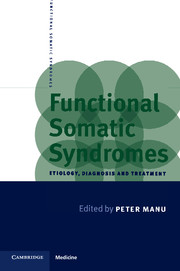Book contents
- Frontmatter
- Contents
- List of contributors
- Preface
- 1 Definition and Etiological Theories
- 2 Chronic Fatigue Syndrome
- 3 Fibromyalgia Syndrome
- 4 Irritable Bowel Syndrome
- 5 Premenstrual Syndrome
- 6 Interstitial Cystitis
- 7 Temporomandibular Disorders
- 8 Chest Pain Syndromes
- 9 Repetitive Strain Injury
- 10 Multiple Chemical Sensitivities
- 11 Psychopharmacology of Functional Somatic Syndromes
- 12 Psychotherapy of Functional Somatic Syndromes
- 13 Determination Of Disability Claimed By Patients With Functional Somatic Syndromes
- 14 Functional Somatic Syndromes: Exploring Common Denominators
- Index
2 - Chronic Fatigue Syndrome
Published online by Cambridge University Press: 08 January 2010
- Frontmatter
- Contents
- List of contributors
- Preface
- 1 Definition and Etiological Theories
- 2 Chronic Fatigue Syndrome
- 3 Fibromyalgia Syndrome
- 4 Irritable Bowel Syndrome
- 5 Premenstrual Syndrome
- 6 Interstitial Cystitis
- 7 Temporomandibular Disorders
- 8 Chest Pain Syndromes
- 9 Repetitive Strain Injury
- 10 Multiple Chemical Sensitivities
- 11 Psychopharmacology of Functional Somatic Syndromes
- 12 Psychotherapy of Functional Somatic Syndromes
- 13 Determination Of Disability Claimed By Patients With Functional Somatic Syndromes
- 14 Functional Somatic Syndromes: Exploring Common Denominators
- Index
Summary
A syndrome of persistent or relapsing fatigue has been the focus of intense public attention and scientific research during the past two decades. From 1982 to 1987 the syndrome was considered by some investigators to be the manifestation of a reactivated Epstein–Barr virus (EBV) infection (Tobi et al., 1982; Dubois et al., 1984; Jones et al., 1985; Straus et al., 1985). As this etiological relationship could not be confirmed (Buchwald et al., 1987; Homes et al., 1987; Hellinger et al., 1988), the US Centers for Disease Control sponsored a proposal to redefine this syndrome on clinical grounds and renamed it the chronic fatigue syndrome (CFS) (Holmes, 1988a).
History
In 1869 the New York neurologist George M. Beard introduced the term ‘neurasthenia’ to describe a condition characterized by a chronic fatigue which was ‘developed, fostered and perpetuated with the advance of culture and refinement, and the corresponding preponderance of labor of the brain over that of the muscles’ (Beard, 1869). He observed that women were more frequently affected than men, especially ‘the sensitive white woman, … torn and cursed by happy and unhappy love; waylaid at all hours by the cruelest of robbers, worry and ambition’ (Beard, 1881).
George Beard's description of neurasthenia proved influential among psychiatrists, a fact most notably reflected in Sigmund Freud's use of the neurasthenic construct to define anxiety neurosis (Freud, 1894).
Keywords
- Type
- Chapter
- Information
- Functional Somatic SyndromesEtiology, Diagnosis and Treatment, pp. 8 - 31Publisher: Cambridge University PressPrint publication year: 1998
- 2
- Cited by

